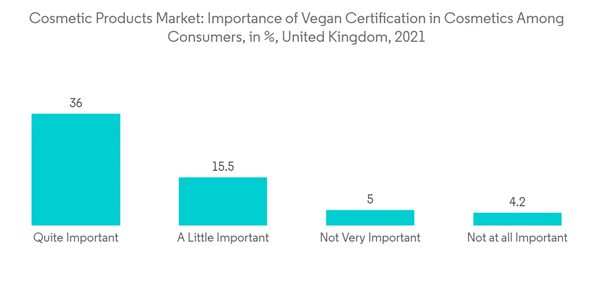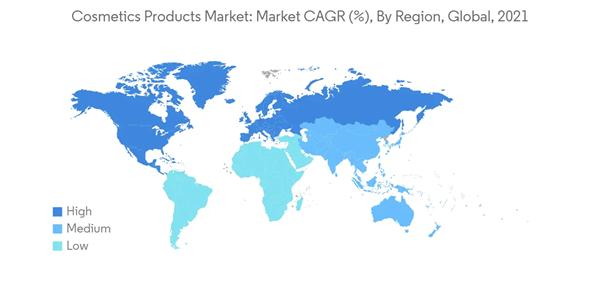Key Highlights
- The cosmetic products market is projected to register a CAGR of 4.94% during the forecasted period.
- The increasing number of working women and rising consciousness regarding physical appearance among millennial women are the key factors driving the market growth. In addition, the rising awareness about the harmful effect of chemical compounds such as paraben and aluminium in the products is stimulating the growth of natural and organic facial cosmetic products in the market.
- Thereby, the manufacturers were focused on innovating facial cosmetics with natural ingredients. Additionally, Heritage brands are losing their popularity. They need to be updated as new storytelling brands emphasizing vegan, cruelty-free, organic, and natural concepts are trying to capture the market by offering a product that matches evolving consumer preferences.
- There is an increasing demand for long-lasting and waterproof makeup, sun protection makeup with SPF, and vitamin enhancement makeup. This, in turn, offers a lucrative opportunity to the key players in the category to innovate in the facial make-up market. For instance, in 2021, Coty Inc. expanded the Gucci beauty product line by launching Gucci Poudre De Beauté Mat Naturel face powder in Asia-Pacific and European markets.
Cosmetic Products Market Trends
Inclination Toward Organic, Vegan and Cruelty-Free Cosmetic Products
- In recent years organic, cruelty-free (no animal testing), vegetarian (no byproducts of animal slaughter), and vegan (no animal ingredients at all) cosmetics market have gained increasing popularity in developed countries, and it has been finding their space in the growing market such as India, China, Brazil, etc. market. Moreover, with the advancement of vegan products, consumers are paying extra attention to a particular shade of lipstick that suits them and its manufacturing process.
- Prolonged use of synthetic cosmetics may cause various health issues, such as irritation, hormonal imbalance, and toxicity. However, cosmetic products made of organic ingredients, such as plant extracts and natural oils, do not harm the skin. Consumers have preferred vegan and organic cosmetics, which drives the market.
- Animal-free alternatives may lead companies to produce lab-grown human skin samples for testing cosmetic products. The ability to create samples on demand reduces costs and increases the accuracy of results. Advancement in techniques means that samples can replicate different skin ages and colors. The increasing demand for vegan cosmetics among millennials and technological advancements drive the market's growth.
Increasing Usage of Cosmetic Products in Asia-Pacific
- The color cosmetics industry (including the eye, facial, and lip makeup categories) is the most prosperous in India, China, and others. Local companies, such as the Shahnaz Husain Group from India, are exclusively providing herbal/ayurvedic cosmetics products due to the prolonged health benefits it offers to the skin.
- Also, premium global brands register increased sales as Indian consumers move from functional items to more advanced and specialized cosmetic products. Many international brands, like Revlon, Elle18 MAC, Sephora, L’Oreal, and Oriflame, are increasing their presence further, by introducing more products in the Indian market, particularly with convenient and attractive packaging types and vegan ingredients, to attract the youth in the country.
- According to the World's Top Exporters, China was the third-largest importer of cosmetics in the world in 2021, with a total value of about USD 18.5 billion. Hong Kong, which imported skincare and cosmetics worth over USD 7.3 billion in 2021, was the next-largest cosmetics importer in Asia-Pacific.
Cosmetic Products Market Competitor Analysis
The cosmetics products market studied is highly competitive, with many regional small- to medium-scale players and key global players such as L’oreal SA, Estée Lauder Inc., LVMH Moët Hennessy Louis Vuitton, etc. Key players differentiate their offerings and compete on different factors, including product offerings, ingredients, packaging, price, functionality, and marketing activities, to gain a competitive advantage. Companies are increasing their investments in R&D and marketing, and they are expanding their distribution channels to maintain their position in the market. Moreover, companies are following strategies that include providing products through e-commerce (own website and third parties) websites to facilitate a larger targeted audience.Additional benefits of purchasing the report:
- The market estimate (ME) sheet in Excel format
- 3 months of analyst support
This product will be delivered within 2 business days.
Table of Contents
Companies Mentioned (Partial List)
A selection of companies mentioned in this report includes, but is not limited to:
- The Estée Lauder Companies Inc.
- L'Oréal S.A.
- Shiseido Company, Limited
- Oriflame Holding AG
- LVMH Moët Hennessy Louis Vuitton
- JAB Cosmetics B.V. (Coty, Inc.)
- Natura & Co
- Revlon, Inc.
- Huda Beauty
- Puig










